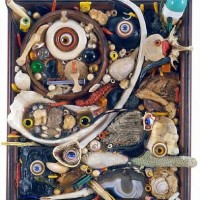Archives: Uncategorized
Robert Rauschenberg – Hiccups

Visitation II 1965 Robert Rauschenberg 1925-2008 Purchased 1985 http://www.tate.org.uk/art/work/P77107







 In Robert Rauschenberg’s Hiccups (1978), ninety-seven sheets of handmade paper zip together to present a swath of imagery that at a distance resembles a color bar, the individual panels surrendering their details in a sweeping line of vibrant squares. All of the panels must be presented when the work is shown, but that is the only restriction on their installation. Hiccups may be hung in a single line (with breaks left for doorways and windows as needed) or stacked in several parallel horizontal rows. When the nine-by-seven inch units are assembled side by side, the work extends nearly sixty-three feet.
In Robert Rauschenberg’s Hiccups (1978), ninety-seven sheets of handmade paper zip together to present a swath of imagery that at a distance resembles a color bar, the individual panels surrendering their details in a sweeping line of vibrant squares. All of the panels must be presented when the work is shown, but that is the only restriction on their installation. Hiccups may be hung in a single line (with breaks left for doorways and windows as needed) or stacked in several parallel horizontal rows. When the nine-by-seven inch units are assembled side by side, the work extends nearly sixty-three feet.
Upon close inspection, each panel presents a unique composite of images, sometimes overlaid with sheer scrims or brightly colored snippets of ribbon and fabric. Gathered from popular magazines, sprayed with solvent, and run through a lithographic press, the transferred images—including maps, landscapes and vegetation, pictures of athletes and other celebrities, and various illustrations—reflect American popular culture of the late 1970s as well as more enduring cultural themes. Because the sheets can be displayed in any order, the recurrence of particular motifs may be emphasized or diminished. A slow walk along the work’s length offers viewers a chance to track the unfolding of an endlessly variable interwoven narrative, extending across time.
Rauschenberg often incorporated scraps of clothing in his paintings and assemblages, using them to reference the human body and the textures of everyday life. A brief stint as a self-described “zipper inspector” for a bathing suit company in 1948 familiarized him with the functional qualities of zippers, and they begin to appear in his work by 1959. In Hiccups, the zippers not only allow the panels to be rearranged in any configuration but also provide the means for mounting them on the wall: simple metal brads are inserted through the holes in the zipper pulls. The zippers also directly structure the experience of viewing the work. The interruptions formed by the alternation of zippers and printed panels visually approximate a staccato rhythm that echoes an actual case of the hiccups.
Source: http://www.sfmoma.org/explore/collection/artwork/31585#ixzz3lf0fhy68
San Francisco Museum of Modern Art
Mixed Media Introduction

It’s likely when you think of “mixed-media” you think of an artwork that combines a variety of painting and drawing materials, perhaps some collage, and maybe a few “found” materials that might correspond to the theme and appearance of the picture. This is correct, except that mixed-media can also take many other forms and appearances, some of which you may not have even considered or heard of. As a general principle, mixed-media is exactly that, a mixing of art or non-art media into a composite that takes on the qualities of a unique or one-of-a-kind artwork. It is intrinsically abstract in appearance, simply because the artist is using things that do not usually go together to represent something realistically. However, mixed-media art can certainly address a theme or a unifying principle such as the box art above seems to suggest some kind of a nest or habitat for storage of strange and exotic birds, bones and other natural accumulations. In the following posts, I have assembled a large number of examples of “mixed-media” artworks. Most all of these have been taken from Pinterest, which can be easily searched for countless more boards and images. I haven’t included artist’s credits on this blog with the pictures, as many don’t include an artist’s credit on Pinterest, but you can access info from the images on my board at: https://www.pinterest.com/olegosipoff/mixed-media-art/
Note: I have put the artwork I have posted into categories according to materials used. Each category includes several examples.
Hello world!
Welcome to LWHS SchoolPress Network. This is your first post. Edit or delete it, then start blogging!
















